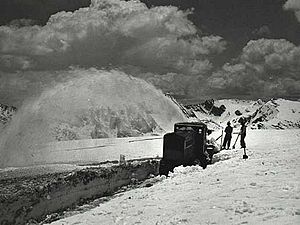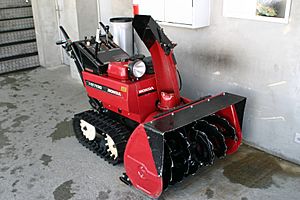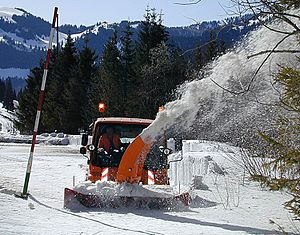Snow blower facts for kids
A snow blower or snow thrower is a machine that helps remove snow. It clears snow from places where it's not wanted. This includes driveways, sidewalks, roadways, and even railroad tracks.
Even though it's called a "blower," it doesn't actually blow snow with air. Instead, it uses a special spinning part called an auger or impeller to move the snow.
Snow blowers can run on electric power (from a cord or battery). They can also use a gasoline or diesel engine. These machines throw snow to another spot. Sometimes, they even load it into a truck to be taken away. This is different from snow plows, which just push snow. Snow blowers usually send the snow out to one side.
These machines come in many sizes. Small ones can clear light snow from a path about 18 to 20 in (457 to 508 mm) wide. Very large ones are mounted on big winter service vehicles. They can clear heavy snow up to 6 feet (1.83 m) deep and 20-foot (6.10 m) wide.
Contents
How Snow Blowers Work
Snow blowers generally come in two main types: single-stage and two-stage. Each type works a bit differently to clear snow.
Single-Stage Snow Blowers
On a single-stage snow blower, a part called an auger does all the work. The auger is a paddle-like part you can see at the front. It pulls the snow into the machine. Then, it pushes the snow directly out of a chute. This chute sends the snow away from the cleared area.
The auger on these machines touches the ground. Because of this, single-stage snow blowers are best for paved surfaces. They are not good for clearing snow from gravel or dirt paths.
Two-Stage Snow Blowers
Two-stage snow blowers use two steps to clear snow. First, the auger pulls the snow into the machine, just like in a single-stage model. But instead of sending it out, the auger feeds the snow into a second part. This second part is a fast-spinning impeller.
The impeller then powerfully throws the snow out of the discharge chute. Two-stage snow blowers can usually handle deeper snow. Also, their augers do not touch the ground. This means they can be used safely on unpaved surfaces.
History of Snow Blowers

People have been trying to find better ways to remove snow for a long time. In 1870, Robert Carr Harris from New Brunswick, Canada, patented a "Railway Screw Snow Excavator." This was an early idea for a snow-clearing machine.
Later, in 1923, Robert E. Cole patented a snowplow. His design used cutters and a fan to blow snow away. However, the person most often given credit for inventing the first practical snow blower is Arthur Sicard.
Arthur Sicard was from Quebec, Canada. He came up with his idea in 1894. By 1925, he finished his first working snow blower. He started his company, Sicard Industries, in 1927. His machines were soon used to clear roads in Outremont, Quebec. Today, his company is part of SMI-Snowblast, Inc.
Jet-Engine Snow Blowers
Some very powerful snow clearers use Jet engines or other gas turbines. These machines are used for clearing large amounts of snow from railway tracks and roads. They first appeared in Russia and Canada in the 1960s. Later, they were brought to the U.S.
A jet-engine snow blower does two things: it melts the snow and blows it away. This helps clear tracks much faster than other methods. These machines are very powerful and lighter for their strength. However, they are also much more expensive than regular snow removal tools. In Russia, sometimes old military jet engines are used to help lower the cost.
Images for kids
-
A tractor with a snow blower in Kuopio, Finland







